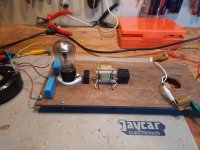https://www.google.com/search?q=rectifier+BR+tube+raytheon
http://www.tubebooks.org/Books/Atwood/Raytheon 1940 Characteristic Data Chart.pdf --page 16
It is a gas tube.
It is not clear that it works today. (The Helium may be gone.)
'When used for battery charger duty, the BH and its counterparts were very successful. However, they produce an enormous amount of "hash" (electrical noise) which had to be filtered out in radio battery eliminators and power supplies. This made such devices big, heavy, and costly. In 1927, RCA released the Westinghouse-designed 280 {5V4} and 281 high vacuum rectifiers, along with their first line of tubes designed for AC operation (e.g. 26, 27, and 71A). That pretty much spelled the end of the battery set era, and gaseous rectifiers with it.
'If you have one of the original brass based, tipped BH tubes, it might bring $10 to $15 at a typical swap meet. The later ones with bakelite bases don't display as well, hence they don't have as much value. BA and BR tubes might fetch a little more due to scarcity, but only if you can find a collector who is looking for them.'
https://www.antiqueradios.com/forums/viewtopic.php?f=19&t=179021
http://www.tubebooks.org/Books/Atwood/Raytheon 1940 Characteristic Data Chart.pdf --page 16
It is a gas tube.
It is not clear that it works today. (The Helium may be gone.)
'When used for battery charger duty, the BH and its counterparts were very successful. However, they produce an enormous amount of "hash" (electrical noise) which had to be filtered out in radio battery eliminators and power supplies. This made such devices big, heavy, and costly. In 1927, RCA released the Westinghouse-designed 280 {5V4} and 281 high vacuum rectifiers, along with their first line of tubes designed for AC operation (e.g. 26, 27, and 71A). That pretty much spelled the end of the battery set era, and gaseous rectifiers with it.
'If you have one of the original brass based, tipped BH tubes, it might bring $10 to $15 at a typical swap meet. The later ones with bakelite bases don't display as well, hence they don't have as much value. BA and BR tubes might fetch a little more due to scarcity, but only if you can find a collector who is looking for them.'
https://www.antiqueradios.com/forums/viewtopic.php?f=19&t=179021
In 1927, RCA released the Westinghouse-designed 280 {5V4} and 281 high vacuum rectifiers, along with their first line of tubes designed for AC operation (e.g. 26, 27, and 71A). That pretty much spelled the end of the battery set era, and gaseous rectifiers with it.
Raytheon gaseous rectifiers persisted well into the 1960s with types 0Z4/0Z4A/0Z4G - indeed, the BA, BR and BH were the valves that saved Raytheon's bacon in the ferociously competitive radio market of the 1920s and 1930s (article attached). The photo is of a BH in action - it was the HT rectifier for my Octogenarian amp.
Attachments
- Home
- Amplifiers
- Tubes / Valves
- Raytheon mystery tube 25
